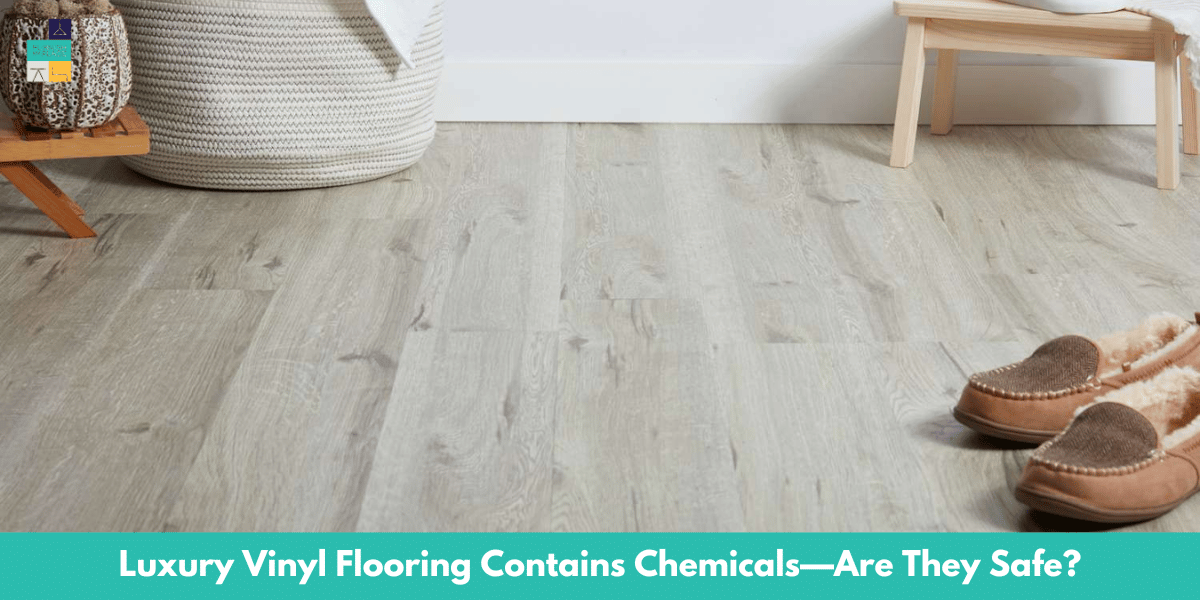Luxury vinyl flooring (LVF) has become incredibly popular due to its durability, affordability, and aesthetic appeal. However, the majority of homeowners feel insecure about using it as residential flooring, especially in terms of indoor air quality (IAQ) and chemical exposure. Although LVF has plenty of benefits, you should be aware of its safety features to make an educated choice.
Here are 4 fast facts about the safety of luxury vinyl flooring, including possible chemical emissions, their contribution to indoor air quality, environmental impacts, and installation methods affecting safety.
1. Luxury Vinyl Flooring Contains Chemicals—Are They Safe?

Understanding Chemical Composition
Luxury vinyl flooring consists primarily of polyvinyl chloride (PVC), a man-made substance that is strong and flexible. Issues have been raised on the volatile organic compounds (VOCs), phthalates, and formaldehyde in certain LVF products. The chemicals have an impact on indoor air quality and cause health concerns such as respiratory irritation, headaches, and allergic responses.
Certified Flooring & Regulations
The positive news is that several certified floor products today meet rigorous safety criteria. Organizations like GreenGuard and FloorScore verify products with minimal emissions and meet safety standards. Certified flooring means reduced exposure to hazardous chemicals, becoming an even safer product for households, particularly households with children, pets, or respiratory sensitivities.
- GreenGuard Certification: Ensures that LVF products emit low VOCs and are safe for use indoors.
- FloorScore Certification: Indicates that the flooring has met rigorous standards for indoor air quality.
- Phthalate-Free Flooring: Certain producers offer phthalate-free LVF for greater safety.
When choosing LVF, you must ensure that it is certified to reduce exposure to dangerous chemicals.
2. How Luxury Vinyl Flooring Affects Indoor Air Quality (IAQ)

Emission Levels and Health Risks
Indoor air quality (IAQ) is a significant part of overall health and wellness. Certain LVF products, particularly those produced using older technologies or unregulated imports, emit high VOC levels that have adverse effects on IAQ
Poor indoor air quality may result in
- Respiratory problems, especially in asthmatic and allergic patients
- Headaches and dizziness that are caused by prolonged exposure to VOCs
- Eye, nose, and throat irritation
Choosing Safer Options
To have a healthy indoor environment, the homeowners should:
- Use low-VOC or zero-VOC LVF that is certified by reputable organizations.
- Select floating floor installations instead of glue-down systems since adhesives can be VOC-emitting, which impacts IAQ.
- Provide adequate ventilation during and after installation to minimize initial emissions.
- Let new flooring “off-gas” in the outside area before bringing it indoors.
Following such steps minimizes chemical exposure and improves indoor air quality for homeowners and families.
3. Is Luxury Vinyl Flooring Eco-Friendly?

Environmental Concerns & Sustainability
Luxury vinyl flooring has long been criticized for its environmental impact, primarily due to its composition of non-biodegradable synthetic materials. Further, conventional production methods of luxury vinyl flooring can lead to pollution and depletion of resources.
However, some firms are already putting more emphasis on sustainable production using recycled materials and reducing toxic emissions. Green LVF alternatives can offer equal durability and appearance but with reduced impact on the environment.
Recycling & Disposal
Appropriate disposal and recycling are necessary to minimize the ecological footprint of LVF. There are regulations for flooring disposal, and some recycling centers will accept used LVF to avoid its disposal in the landfill. Homeowners can determine local regulations to dispose of used vinyl flooring.
Eco-Friendly LVF Options
- Recycled Content LVF: Some companies use post-consumer recyclable vinyl to create eco-friendly flooring.
- Non-Toxic Vinyl Flooring: Some manufacturers offer PVC-free or low-toxin versions.
- Reusable LVF: Some products on the floor can be reused rather than discarded.
Choosing sustainable LVF alternatives encourages sustainability programs and yields long-term performance.
4. Installation Methods & Their Impact on Safety

How Installation Affects Safety
Luxury vinyl flooring is installed in several ways, and each method affects safety in different ways. Some of the methods involve adhesives that release VOCs, while others minimize exposure.
Installation Methods and Their Impact
- Floating Floors (Click-Lock LVF): No adhesive required, safer alternative, and reduced VOC exposure.
- Glue-Down LVF: Incorporates powerful adhesives that possibly have chemicals affecting IAQ. Always utilize low-VOC adhesives.
- Loose Lay LVF: Loose Lay LVF is not adhesive and is simple to fit, making it one of the safest alternatives.
Safer Installation Tips
- Use low-VOC adhesives if a glue-down installation is used.
- Ensure good ventilation through and after installation.
- Allow new flooring to “off-gas” before placing furniture in the room.
- Choose skilled installers who will follow safety guidelines.
Choosing the appropriate installation is a big part of home health and safety.
LVP Flooring for a Healthy Home Environment in North Carolina
When selecting LVF in North Carolina, residents should select certified, low-VOC, and environmentally friendly products. The majority of reputable producers now offer secure and sustainable luxury vinyl flooring for different types of home settings, such as pet-friendly, family, and rental homes.
Local North Carolina stores offer a selection of premium quality, safe luxury vinyl flooring (LVF) products that are designed to meet stringent safety and indoor air quality standards.
Conclusion
Luxury vinyl flooring remains popular due to its durability, affordability, and look. However, homeowners should be wary of the chemical content, indoor air quality impact, environmental implications, and installation process to prevent harm.
Key Takeaways
- GreenGuard and FloorScore-certified LVF guarantees low VOC emissions and improved indoor air quality.
- Low indoor air quality because of high-VOC flooring induces respiratory and health problems, but low-emission product selection averts dangers.
- There are also recyclable and sustainable LVF solutions for environmentally friendly homeowners.
- Installation processes significantly affect safety; thus, floating floors are more suitable than glue-down for VOC exposure reduction.
By making smart decisions, homeowners can benefit from luxury vinyl flooring while maintaining a healthy and safe indoor environment.
Does luxury vinyl flooring release toxic chemicals?
Certain LVF products emit VOCs, but certified flooring guarantees low off-gassing levels.
Which certification signifies safe LVF?
Check for GreenGuard, FloorScore, and low-VOC certification on safe floors.
Can luxury vinyl flooring impact indoor air quality?
Yes, particularly if it has high levels of VOCs. Low-emission alternatives should be used.
Is luxury vinyl flooring environmentally friendly?
Some but not all LVF options are recycled and sustainable.
What is the safest method to install LVF?
Floating floors are usually safer than glue-downs because of reduced VOC exposure.
How do I minimize chemical exposure from vinyl flooring?
Use certified products, provide proper ventilation, and allow flooring to off-gas.
Are all luxury vinyl flooring products safe?
No, always verify certificates and manufacturer information before purchasing.


